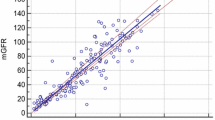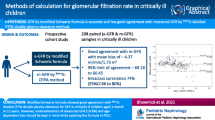Abstract
Objective
To verify whether the new Asian modified CKD-EPI equation improved the performance of original one in determining GFR in Chinese patients with CKD.
Method
A well-designed paired cohort was set up. Measured GFR (mGFR) was the result of 99mTc-diethylene triamine pentaacetic acid (99mTc-DTPA) dual plasma sample clearance method. The estimated GFR (eGFR) was the result of the CKD-EPI equation (eGFR1) and the new Asian modified CKD-EPI equation (eGFR2). The comparisons were performed to evaluate the superiority of the eGFR2 in bias, accuracy, precision, concordance correlation coefficient and the slope of regression equation and measure agreement.
Results
A total of 195 patients were enrolled and analyzed. The new Asian modified CKD-EPI equation improved the performance of the original one in bias and accuracy. However, nearly identical performance was observed in the respect of precision, concordance correlation coefficient, slope of eGFR against mGFR and 95 % limit of agreement. In the subgroup of GFR < 60 mL min−1/1.73 m2, the bias of eGFR1 was less than eGFR2 but they have comparable precision and accuracy. In the subgroup of GFR > 60 mL min−1/1.73 m2, eGFR2 performed better than eGFR1 in terms of bias and accuracy.
Conclusion
The new Asian modified CKD-EPI equation can lead to more accurate GFR estimation in Chinese patients with CKD in general practice, especially in the higher GFR group.


Similar content being viewed by others
References
Levey AS, Atkins R, Coresh J, Cohen EP, Collins AJ, Eckardt KU et al (2007) Chronic kidney disease as a global public health problem: approaches and initiatives—a position statement from kidney disease improving global outcomes. Kidney Int 72:247–259
Kim NH, Hyun YY, Lee KB, Chang Y, Ryu S et al (2015) Environmental heavy metal exposure and chronic kidney disease in the general population. J Korean Med Sci 30(3):272–277
Zhang Q-L, Rothenbacher D (2008) Prevalence of chronic kidney disease in population-based studies: systematic review. BMC Public Health 8:117
Kaze FF, Meto DT, Halle MP, Ngogang J, Kengne AP (2015) Prevalence and determinants of chronic kidney disease in rural and urban Cameroonians: a cross-sectional study. BMC Nephrol 30(16):117
Jessani S, Bux R, Jafar TH (2014) Prevalence, determinants, and management of chronic kidney disease in Karachi, Pakistan—a community based cross-sectional study. BMC Nephrol 15:90
Lee CK, Swinford RD, Cerda RD, Portman RJ, Hwang W et al (2012) Evaluation of serum creatinine concentration-based glomerular filtration rate equations in pediatric patients with chronic kidney disease. Pharmacotherapy 32(7):642–648
Lujambio I, Sottolano M, Luzardo L, Robaina S, Krul N et al (2014) Estimation of glomerular filtration rate based on serum cystatin C versus creatinine in a Uruguayan population. Int J Nephrol 2014:837106
Lopez-Giacoman S, Madero M (2015) Biomarkers in chronic kidney disease, from kidney function to kidney damage. World J Nephrol 4(1):57–73
Levey AS, Coresh J (2012) Chronic kidney disease. Lancet 379:165–180
Cockcroft DW, Gault MH (1976) Prediction of creatinine clearance from serum creatinine. Nephron 16(1):31–41
Levey AS, Bosch JP, Lewis JB, Greene T, Rogers N et al (1999) Modification of Diet in Renal Disease Study Group. A more accurate method to estimate glomerular filtration rate from serum creatinine: a new prediction equation. Ann Intern Med 130(6):461–470
Liu X, Gan X, Chen J, Lv L, Li M et al (2014) A new modified CKD-EPI equation for Chinese patients with type 2 diabetes. PLoS One 9(10):e109743
Levey AS, Stevens LA, Schmid CH, Zhang YL, Castro AF et al (2009) CKD-EPI (Chronic Kidney Disease Epidemiology Collaboration). A new equation to estimate glomerular filtration rate. Ann Intern Med 150(9):604–612
Larsson A, Malm J, Grubb A, Hansson LO (2004) Calculation of glomerular filtration rate expressed in mL/min from plasma cystatin C values in mg/L. Scand J Clin Lab Invest 64(1):25–30
Grubb A, Nyman U, Björk J, Lindström V, Rippe B et al (2005) Simple cystatin C-based prediction equations for GFR compared with the MDRD prediction equation for adults and the Schwartz and the Counahan–Barratt prediction equations for children. Clin Chem 51(8):1420–1431
Gates GF (1982) Glomerular filtration rate: estimation from fractional renal accumulation of 99 Tcm-DTPA (stannous). Am J Roentgenol 138(3):565–570
Chen J, Tang H, Huang H, Lv L, Wang Y, Liu X et al (2015) Development and validation of new glomerular filtration rate predicting models for Chinese patients with type 2 diabetes. J Transl Med 13:317
Xie P, Huang JM, Lin HY, Wu WJ, Pan LP (2013) CKD-EPI equation may be the most proper formula based on creatinine in determining glomerular filtration rate in Chinese patients with chronic kidney disease. Int Urol Nephrol 45(4):1057–1064
Stevens LA, Schmid CH, Greene T, Zhang YL, Beck GJ et al (2010) Comparative performance of the CKD epidemiology collaboration (CKD-EPI) and the Modification of Diet in Renal Disease (MDRD) study equations for estimating GFR levels above 60 ml min−1 1.73 m−2. Am J Kidney Dis 56(3):486–495
White CA, Akbari A, Doucette S, Fergusson D, Knoll GA (2010) Estimating glomerular filtration rate in kidney transplantation: is the new chronic kidney disease epidemiology collaboration equation any better? Clin Chem 56(3):474–477
Pei XH, He J, Liu Q, Zhu B, Bao LH et al (2012) Evaluation of serum creatinine- and cystatin C-based equations for the estimation of glomerular filtration rate in a Chinese population. Scand J Urol Nephrol 46(3):223–231
Kilbride HS, Stevens PE, Eaglestone G, Knight S, Carter JL, Delaney MP et al (2013) Accuracy of the MDRD (Modification of Diet in Renal Disease) study and CKD-EPI (CKD Epidemiology Collaboration) equations for estimation of GFR in the elderly. Am J Kidney Dis 61(1):57–66
Hebert SA, Molony DA (2015) ACP Journal Club: the CKD-EPI equation for eGFR predicted adverse outcomes after PCI better than other equations. Ann Intern Med 163(10):JC12
Stevens LA, Claybon MA, Schmid CH, Chen J, Horio M et al (2011) Evaluation of the Chronic Kidney Disease Epidemiology Collaboration equation or estimating the glomerular filtration rate in multiple ethnicities. Kidney Int 79:555–562
Xie P, Huang J-M, Liu X-M, Wu W-J, Pan L-P et al (2013) 99mTc-DTPA renal dynamic imaging method may be unsuitable to be used as the reference method in investigating the validity of CKD-EPI equation for determining glomerular filtration rate. PLoS One 8(5):e62328
Haycock GB, Schwartz GJ, Wisotsky DH (1978) Geometric method for measuring body surface area: a height-weight formula validated in infants, children and adults. J Pediatr 93(1):62–66
Banfi G, Del Fabbro M, Lippi G (2006) Relation between serum creatinine and body mass index in elite athletes of different sport disciplines. Br J Sports Med 40:675–678
Baxmann AC, Ahmed MS, Marques NC, Menon VB, Pereira AB, Kirsztajn GM et al (2008) Influence of muscle mass and physical activity on serum and urinary creatinine and serum cystatin C. Clin J Am Soc Nephrol 3:348–354
Author contributions
YQ Provided and used the software.PX and JMH conceived and designed the experiments. PX, JMH, ZF, LGW, PF and LPP performed the experiments. PX and JMH analyzed the data. PX, JMH and YQ contributed reagents/materials/analysis tools. PX and JMH Wrote the paper.
Author information
Authors and Affiliations
Corresponding author
Ethics declarations
Conflict of interest
The authors have declared that no competing interests exist.
Additional information
This paper was partially supported by training and basic fund of clinical medicine provided by Finance Department of Hebei Province (2016).
Rights and permissions
About this article
Cite this article
Wang, J., Xie, P., Huang, Jm. et al. The new Asian modified CKD-EPI equation leads to more accurate GFR estimation in Chinese patients with CKD. Int Urol Nephrol 48, 2077–2081 (2016). https://doi.org/10.1007/s11255-016-1386-9
Received:
Accepted:
Published:
Issue Date:
DOI: https://doi.org/10.1007/s11255-016-1386-9




